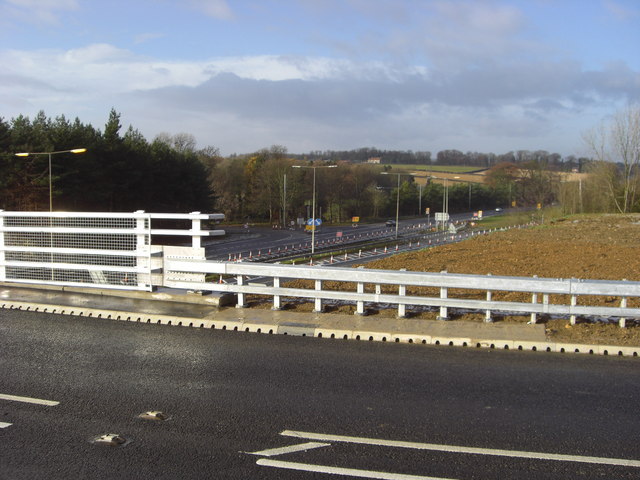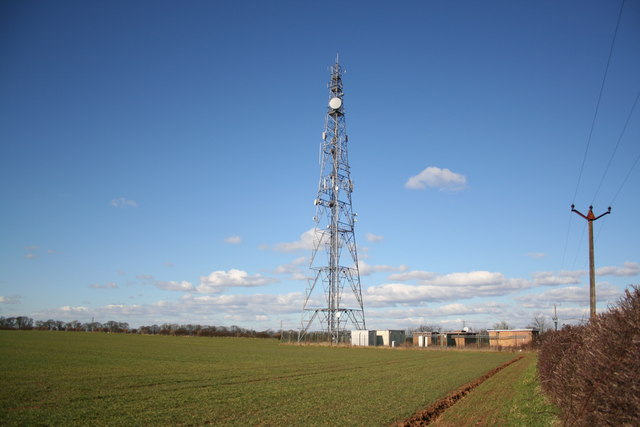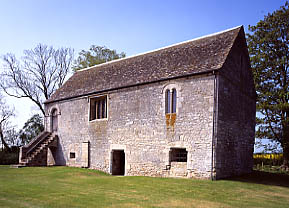|
High Dyke, Lincolnshire
High Dyke is a minor road following a length of the Roman Road Ermine Street in the English county of Lincolnshire, between Woolsthorpe-by-Colsterworth and Ancaster, and onwards nearly to Bracebridge Heath. It is also the name of a small settlement on that road, south-east from Great Ponton, near to the mouth of Stoke Tunnel on the East Coast Main Line. High Dyke is also a name for the general area between Easton and Great Ponton. On the Ordnance Survey 1:25000 sheets it is spelled ''High Dike''. Junctions Recent rebuilding of the A1 road junction at Woolsthorpe-by-Colsterworth in 2008 has included construction of a grade-separated road crossing in place of the disused railway bridge that was part of the High Dyke branch, a mineral railway used to export iron ore between 1916 and 1973. There is a roundabout adjacent to Prince William of Gloucester Barracks east of Grantham, but all other junctions are conventional grade-level crossroads or T junctions. Route The m ... [...More Info...] [...Related Items...] OR: [Wikipedia] [Google] [Baidu] |
Roman Roads In Britain
Roman roads in Britannia were initially designed for military use, created by the Roman Army during the nearly four centuries (AD 43–410) that Britannia was a province of the Roman Empire. It is estimated that about of paved trunk roads (surfaced roads running between two towns or cities) were constructed and maintained throughout the province. Most of the known network was complete by 180. The primary function of the network was to allow rapid movement of troops and military supplies, but it subsequently provided vital infrastructure for commerce, trade and the transportation of goods. A considerable number of Roman roads remained in daily use as core trunk roads for centuries after the end of Roman rule in Britain in 410. Some routes are now part of the UK's national road network. Others have been lost or are of archeological and historical interest only. After the Romans departed, systematic construction of paved highways in the United Kingdom did not resume un ... [...More Info...] [...Related Items...] OR: [Wikipedia] [Google] [Baidu] |
A1 Road (Great Britain)
The A1 is the longest numbered road in the UK, at . It connects Greater London, London, the capital of England, with Edinburgh, the capital of Scotland. It passes through or near North London, Hatfield, Hertfordshire, Hatfield, Welwyn Garden City, Stevenage, Baldock, Letchworth, Letchworth Garden City, Biggleswade, St Neots, Huntingdon, Peterborough, Stamford, Lincolnshire, Stamford, Grantham, Newark-on-Trent, Retford, Doncaster, York, Pontefract, Wetherby, Ripon, Darlington, Durham, England, Durham, Sunderland, Tyne and Wear, Sunderland, Gateshead, Newcastle upon Tyne, Morpeth, Northumberland, Morpeth, Alnwick and Berwick-upon-Tweed. It was designated by the Department for Transport, Ministry of Transport in 1921, and for much of its route it followed various branches of the historic Great North Road (Great Britain), Great North Road, the main deviation being between Boroughbridge and Darlington. The course of the A1 has changed where towns or villages have been bypass (road), ... [...More Info...] [...Related Items...] OR: [Wikipedia] [Google] [Baidu] |
Old Somerby
Old Somerby (pronounced ''Summerby'') is a village and civil parish in the South Kesteven district of Lincolnshire, England, south-east of Grantham. It lies on the B1176 road, with the village centre about east of its junction with the A52 and B6403, and adjacent to the East Coast Main Line. Structure The civil parish population at the 2011 census was 224. Adjacent villages are Ropsley and Boothby Pagnell. The village divides into Old Somerby, High Somerby and Low Somerby. Amenities The church parish is part of The North Beltisloe Group of Beltisloe Deanery in the Diocese of Lincoln. Its church in High Somerby is dedicated to St Mary Magdalene, the same dedication as at nearby Bitchfield. There is bed-and-breakfast accommodation in School Lane. The village public house is the ''Fox and Hounds'' in Grantham Road (B1176). Schools, shops and other amenities are available in Grantham (, to which there are occasional daytime, weekday buses. Heritage Somerby was a colony ... [...More Info...] [...Related Items...] OR: [Wikipedia] [Google] [Baidu] |
Londonthorpe And Harrowby Without
Londonthorpe and Harrowby Without is a civil parish in the South Kesteven district of Lincolnshire, England. According to the 2001 Census it had a population of 4,344, in 1743 households, increasing to a population of 5,133 at the 2011 census. It includes the village of Londonthorpe and the hamlet of Harrowby, Lincolnshire. Originally a township of Grantham, Harrowby was created a civil parish in 1866, and in 1894 it was split into two separate civil parishes, Harrowby Within, and Harrowby Without. In 1909 Harrowby Within was abolished and merged with the town of Grantham. In October 1930 Harrowby Without was reduced in size to enlarge the town, and in 1931 the parish was abolished and merged with Londonthorpe and Spittlegate Without to create Londonthorpe and Harrowby Without civil parish. Geography The parish is bounded on the east by the High Dyke (Ermine Street), the modern B6403 road. The Southern boundary follows traditional field lines from near ''Griffs Plantation ... [...More Info...] [...Related Items...] OR: [Wikipedia] [Google] [Baidu] |
Little Ponton
Little Ponton is a village in the South Kesteven Non-metropolitan district, district of Lincolnshire, England. It lies south of Grantham, about above sea level. Its population is included in that of the civil parish of Little Ponton and Stroxton. History Part of the Roman roads in Britain, Roman road of Ermine Street (known locally as the High Dyke, Lincolnshire, High Dyke) passes through the parish. The village belonged to the historical hundred (county subdivision), wapentake of Winnibriggs and Threo. It was described in John Marius Wilson's ''Imperial Gazetteer of England and Wales'' (1870–1872) as "a parish in Grantham district, Lincoln; on Ermine-street, the river Witham, and the Great Northern railway, 1½ miles N of Great Ponton r. station, and 2 S of Grantham. It has a post-office under Grantham. Acres, 1, 490. Real property, £2,590. Pop., 208. Houses, 43. The property belongs to Turnor, Esq. P. Hall was occupied formerly by the Duke of Cleveland, and is occupied no ... [...More Info...] [...Related Items...] OR: [Wikipedia] [Google] [Baidu] |
Little Ponton And Stroxton
Little Ponton and Stroxton is a civil parish in the South Kesteven district of Lincolnshire, England. According to the 2001 Census it had a population of 135 across 62 homes, increasing to 235 at the 2011 census. The civil parish contains the villages of Little Ponton and Stroxton, the Nature reserve of ''Woodnock Valley'', The site of a Roman settlement, and part of the Roman road of Ermine Street (known locally as the High Dyke). Civil parish The parish was created in 1931 by combining the former civil parishes of ''Little Ponton'' and ''Stroxton''. Local democracy is represented by a parish council, which has been criticised for certain technical failings. History The site of a Roman settlement at Saltersford on the Witham has been identified as the Roman town of '' Causennae'' or '' Causennis'' mentioned in the Antonine itinerary. Saltersford itself was part of an ancient trading route from Droitwich to the Wash. Part of the Roman road of Ermine Street (known locall ... [...More Info...] [...Related Items...] OR: [Wikipedia] [Google] [Baidu] |
Boothby Pagnell
Boothby Pagnell is a village and civil parish in the South Kesteven district of Lincolnshire, England. The population is now included in the civil parish of Bitchfield and Bassingthorpe. History The village lay in the historical wapentake of Winnibriggs and Threo. Boothby Pagnell has a Grade I listed surviving fragment of a medieval manor house, in the Norman style, dating from around 1200 AD. The village was a small community, its population in 1086 being just 19. It has archaeological remains at Cooks Close, a field west of the church, which is chiefly of medieval housing that seems to have fallen into disuse and dereliction by the 14th century, possibly as a result of the fall in the workforce in the aftermath of the Black Death. John de Bothby, Lord Chancellor of Ireland, was born here about 1320 and took his name from the village. Isaac Newton Although his uncle William Ayscough, the brother of Hannah Ayscough, was vicar of nearby Burton Coggles, during his peri ... [...More Info...] [...Related Items...] OR: [Wikipedia] [Google] [Baidu] |
Bassingthorpe
Bassingthorpe is a small village in the South Kesteven district of Lincolnshire, England. It is in the civil parish of Bitchfield and Bassingthorpe, south from Grantham, and on a C class road between the B6403 to the west and the B1176 to the east. The village contains 4 houses and a Grade I listed church dedicated to St Thomas. The ecclesiastical parish is part of The North Beltisloe Group of parishes, of the Deanery of Beltisloe in the Diocese of Lincoln The Diocese of Lincoln forms part of the Province of Canterbury in England. The present diocese covers the ceremonial county of Lincolnshire. History The diocese traces its roots in an unbroken line to the Pre-Reformation Diocese of Leices .... From 2006 to 2011 the incumbent was Rev Richard Ireson. [...More Info...] [...Related Items...] OR: [Wikipedia] [Google] [Baidu] |
Stoke Rochford
Stoke Rochford is a small English village and civil parish south of Grantham in the South Kesteven district of Lincolnshire. The population at the time of the 2011 census was 230 (including Easton, Lincolnshire, Easton). It has two notable Grade I listed buildings: Stoke Rochford Hall and the doubly dedicated St Mary and St Andrew's Church. History Stoke Rochford church was originally dedicated to St Mary. The village was originally called ''South Stoke'' until the expansion of the park in 1843, when ''North Stoke'' was removed. The village was laid out in 1843 to complement the architectural scheme of the new hall, built for Christopher Turnor MP, Christopher Turnor by William Burn."A Short History of Stoke Rochford Hall" Wayback Machine, Internet Archive for Stokerochfor ... [...More Info...] [...Related Items...] OR: [Wikipedia] [Google] [Baidu] |
Easton, Lincolnshire
Easton is a village in the South Kesteven district of Lincolnshire, England, almost north of Colsterworth, and east of the A1 road. It belongs to the civil parish of Stoke Rochford. History The village has no church, but forms part of the North and South Stoke with Easton church parish, which contains the church of St Andrew and St Mary at Stoke Rochford, just inside Easton civil parish. The A1 within the parish was straightened when converted to a dual-carriageway in 1960. The village is still largely the size as it was at the time of the ''Domesday Book''. Easton Hall Sir Henry Cholmeley bought the manor in 1592; his direct descendant Sir Montague Cholmeley rebuilt the village in the early 19th century. Easton Hall (52°49'46.04"N 0°37'29.34"W) was built by Sir Henry Cholmeley, partly rebuilt in 1805, and enlarged in the Victorian period. It was damaged while used by the army during the Second World War and pulled down in 1951. The 12 acres of gardens were abandoned in ... [...More Info...] [...Related Items...] OR: [Wikipedia] [Google] [Baidu] |
Refrigeration
The term refrigeration refers to the process of removing heat from an enclosed space or substance for the purpose of lowering the temperature.International Dictionary of Refrigeration, http://dictionary.iifiir.org/search.phpASHRAE Terminology, https://www.ashrae.org/technical-resources/free-resources/ashrae-terminology Refrigeration can be considered an artificial, or human-made, cooling method. Refrigeration refers to the process by which energy, in the form of heat, is removed from a low-temperature medium and transferred to a high-temperature medium. This work of energy transfer is traditionally driven by mechanical means, but can also be driven by heat, magnetism, electricity, laser, or other means. Refrigeration has many applications, including household refrigerators, industrial freezers, cryogenics, and air conditioning. Heat pumps may use the heat output of the refrigeration process, and also may be designed to be reversible, but are otherwise similar to air conditioning ... [...More Info...] [...Related Items...] OR: [Wikipedia] [Google] [Baidu] |
Norbert Dentressangle
Norbert Dentressangle () was a major European transport, logistics and freight forwarder. It was founded in 1979, initially concentrating on cross channel transport between France and the United Kingdom. In December 2007, Norbert Dentressangle doubled its size, and significantly strengthened its position in Europe, with the acquisition of Christian Salvesen, and in March 2011, it bought the British company TDG. The company reported proforma revenues of €3.8 billion for 2012. In July 2014, Norbert Dentressangle announced that it would be acquiring Jacobson Companies, a United States based 3PL, for $750 million. Jacobson Companies was then the third largest 3PL in the world. Norbert Dentressangle operated from five hundred sites in twenty European countries, and - at one time - employed 33,000 people. On 28 April 2015, the group XPO Logistics XPO is an American transportation company that conducts less-than-truckload shipping. The company's headquarters are located in Gree ... [...More Info...] [...Related Items...] OR: [Wikipedia] [Google] [Baidu] |







